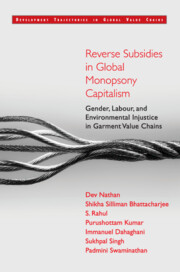 Reverse Subsidies in Global Monopsony Capitalism
Reverse Subsidies in Global Monopsony Capitalism 12 - Conclusion
Published online by Cambridge University Press: 21 January 2022
Summary
In Chapter 1, a subsidy was defined as the purchase of a product, such as labour power, or an environmental service, such as water, below their cost of production. The cost of production of a commodity is the sum of the various inputs that go into its making, plus a normal profit for capital. This is Marx's prices of production or also a neo-Keynesian definition of cost. The difference between the cost of production and the price of the product, however, does not just disappear from the value chain. The cost is incurred somewhere, either in the household where labour is reproduced or within the environment. If this incurred cost is not compensated, it appears as a subsidy extracted from the household or environment.
The extraction of the subsidy takes place in multiple locations: the factory and other sites of production, such as worker and farmer households, and also the environment. Thus, it may seem that the subsidy is being provided to or benefiting the producer, which is the factory owner in the value chain. However, monopsony relations in the value chain result in the capture of that subsidy by the brands, who are able to keep supplier prices down to incurred monetary costs. Thus, there is a distinction between the site of subsidy extraction, which is the supplier factory, and the site of its capture, which occurs through the monopsony relation between brands and suppliers. This is important in the analysis of global value chains (GVCs), such as that of garments, where the monopsony structure of the input market enables the capture of subsidy by the brands even when the extraction of that subsidy takes place under the management of the supplier or local authorities in supplier countries.
Consequently, since the subsidy (in terms of lower prices of inputs) translates into lower ex-factory prices of garments, the subsidies are reverse subsidies to brands—from gendered labour, farmer households, and the environment. These are reverse subsidies in two senses. The first is that they are extracted from the weakest and worst-off in the value chain. The second is that they do not accrue to supplier firms; rather, through the monopsony structure, they are transferred to the brands.
- Type
- Chapter
- Information
- Reverse Subsidies in Global Monopsony CapitalismGender, Labour, and Environmental Injustice in Garment Value Chains, pp. 225 - 252Publisher: Cambridge University PressPrint publication year: 2022
